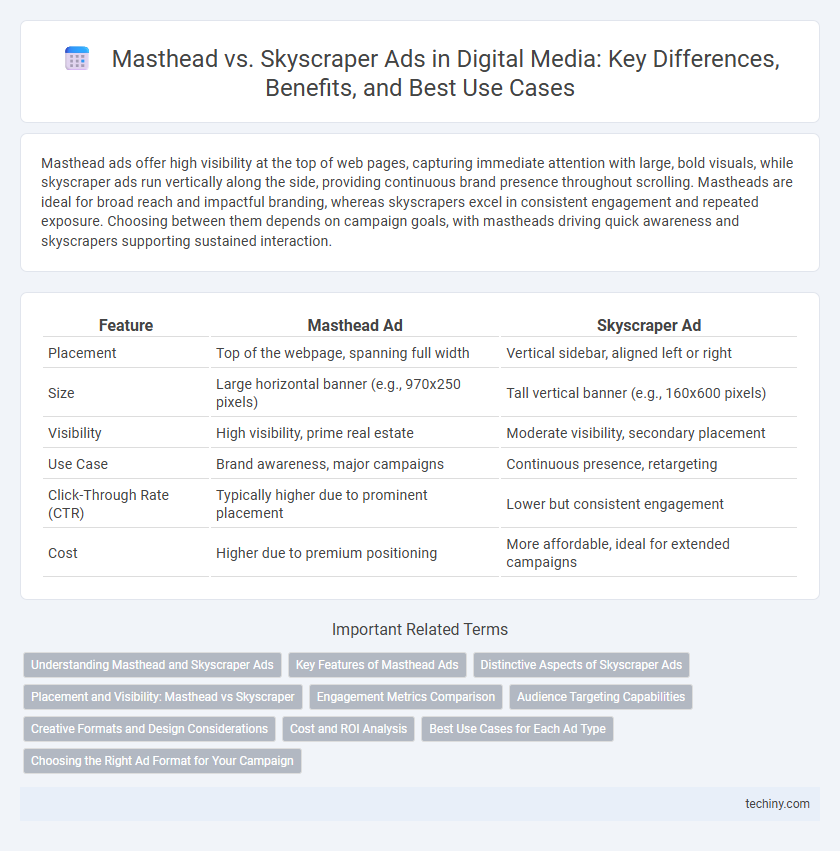Masthead ads offer high visibility at the top of web pages, capturing immediate attention with large, bold visuals, while skyscraper ads run vertically along the side, providing continuous brand presence throughout scrolling. Mastheads are ideal for broad reach and impactful branding, whereas skyscrapers excel in consistent engagement and repeated exposure. Choosing between them depends on campaign goals, with mastheads driving quick awareness and skyscrapers supporting sustained interaction.
Table of Comparison
| Feature | Masthead Ad | Skyscraper Ad |
|---|---|---|
| Placement | Top of the webpage, spanning full width | Vertical sidebar, aligned left or right |
| Size | Large horizontal banner (e.g., 970x250 pixels) | Tall vertical banner (e.g., 160x600 pixels) |
| Visibility | High visibility, prime real estate | Moderate visibility, secondary placement |
| Use Case | Brand awareness, major campaigns | Continuous presence, retargeting |
| Click-Through Rate (CTR) | Typically higher due to prominent placement | Lower but consistent engagement |
| Cost | Higher due to premium positioning | More affordable, ideal for extended campaigns |
Understanding Masthead and Skyscraper Ads
Masthead ads dominate the top section of a webpage, offering high visibility and immersive branding opportunities that capture immediate user attention. Skyscraper ads are vertical banners placed along the sidebars, effective for sustained visibility without interrupting the main content flow. Both ad formats serve distinct strategic roles in digital media campaigns, maximizing reach and engagement through their unique placements.
Key Features of Masthead Ads
Masthead ads occupy prominent horizontal positions at the top of web pages, delivering high visibility and extensive brand exposure through large, visually impactful formats. These ads often include rich media elements like video autoplay and interactive features, enhancing user engagement and click-through rates. Designed for premium placements on high-traffic websites such as YouTube or news portals, masthead ads maximize reach and drive awareness in digital media campaigns.
Distinctive Aspects of Skyscraper Ads
Skyscraper ads are tall, vertical digital banners typically measuring 120x600 or 160x600 pixels, designed for placement along webpage sidebars to maximize screen real estate without disrupting content flow. Their continuous visibility during scrolling enhances brand recall and user engagement by maintaining persistent exposure compared to horizontal masthead ads. Skyscraper ads also offer high click-through rates due to their prominent placement and ability to incorporate interactive elements, making them a powerful tool in digital advertising campaigns.
Placement and Visibility: Masthead vs Skyscraper
Masthead ads dominate the top of web pages, ensuring prime visibility with large-format displays that capture user attention immediately upon page load. Skyscraper ads run vertically along the sidebars, benefiting from consistent visibility during scrolling but often competing with other sidebar content. The strategic placement of mastheads suits high-impact brand awareness campaigns, while skyscrapers offer sustained exposure for longer user engagement periods.
Engagement Metrics Comparison
Masthead ads on digital platforms generate higher click-through rates (CTR) and brand recall compared to skyscraper ads due to their prominent placement and expansive visual format. Skyscraper ads typically yield lower engagement metrics but offer sustained visibility through fixed side panels, supporting long-term brand awareness. Data from industry reports indicate masthead ads achieve an average CTR of 1.5-2.0%, whereas skyscraper ads hover around 0.5-1.0%, highlighting significant differences in user interaction.
Audience Targeting Capabilities
Masthead ads provide broad visibility on premium digital platforms, targeting audiences through high-impact placements often on homepage banners with limited granular targeting options. Skyscraper ads utilize vertical space to engage niche audiences by leveraging advanced targeting parameters such as demographics, interests, and behavioral data for precise reach. Brands aiming for mass exposure favor masthead ads, while those seeking refined audience segmentation benefit from skyscraper ad formats.
Creative Formats and Design Considerations
Masthead ads, typically large and prominently placed at the top of web pages, demand bold visuals and concise messaging to capture immediate attention, while skyscraper ads, vertical banners along the page sides, require elongated, scroll-friendly designs that maintain visibility without overwhelming content. Creative formats for masthead ads often include rich media elements like video and interactive features to maximize engagement, whereas skyscraper ads rely on striking imagery and clear calls-to-action optimized for vertical space. Design considerations must balance user experience with brand impact, ensuring mastheads do not disrupt navigation and skyscraper ads remain adaptive across different screen sizes and devices.
Cost and ROI Analysis
Masthead ads typically command higher costs due to their prime, large-format placement atop websites, resulting in significant visibility but requiring a substantial budget investment. Skyscraper ads offer a more cost-effective solution with vertical, sidebar placements that generate consistent engagement at a lower price point. ROI analysis reveals masthead ads deliver rapid, high-impact brand exposure ideal for awareness campaigns, while skyscraper ads provide steady returns suitable for sustained audience targeting and lead generation.
Best Use Cases for Each Ad Type
Masthead ads are most effective for high-impact brand awareness on premium web pages, often dominating the top of homepage layouts to capture large audience attention quickly. Skyscraper ads excel in vertical spaces alongside content, ideal for sustained user engagement and repeated impressions during long page visits. Choosing between Masthead and Skyscraper ads depends on campaign goals: use Masthead for broad visibility and Skyscraper for targeted engagement within content-rich environments.
Choosing the Right Ad Format for Your Campaign
Masthead ads dominate premium digital media spaces with large, brand-focused visuals ideal for broad audience reach, while skyscraper ads offer vertical, sidebar placements effective for sustained visibility and targeted messaging. Choosing the right ad format depends on campaign objectives, budget constraints, and the desired user engagement levels across platforms like Google Display Network or social media channels. Analyzing performance metrics such as click-through rates and viewability can guide marketers to optimize ROI by selecting the ad format that aligns best with specific campaign goals.
Masthead vs Skyscraper Ad Infographic

 techiny.com
techiny.com